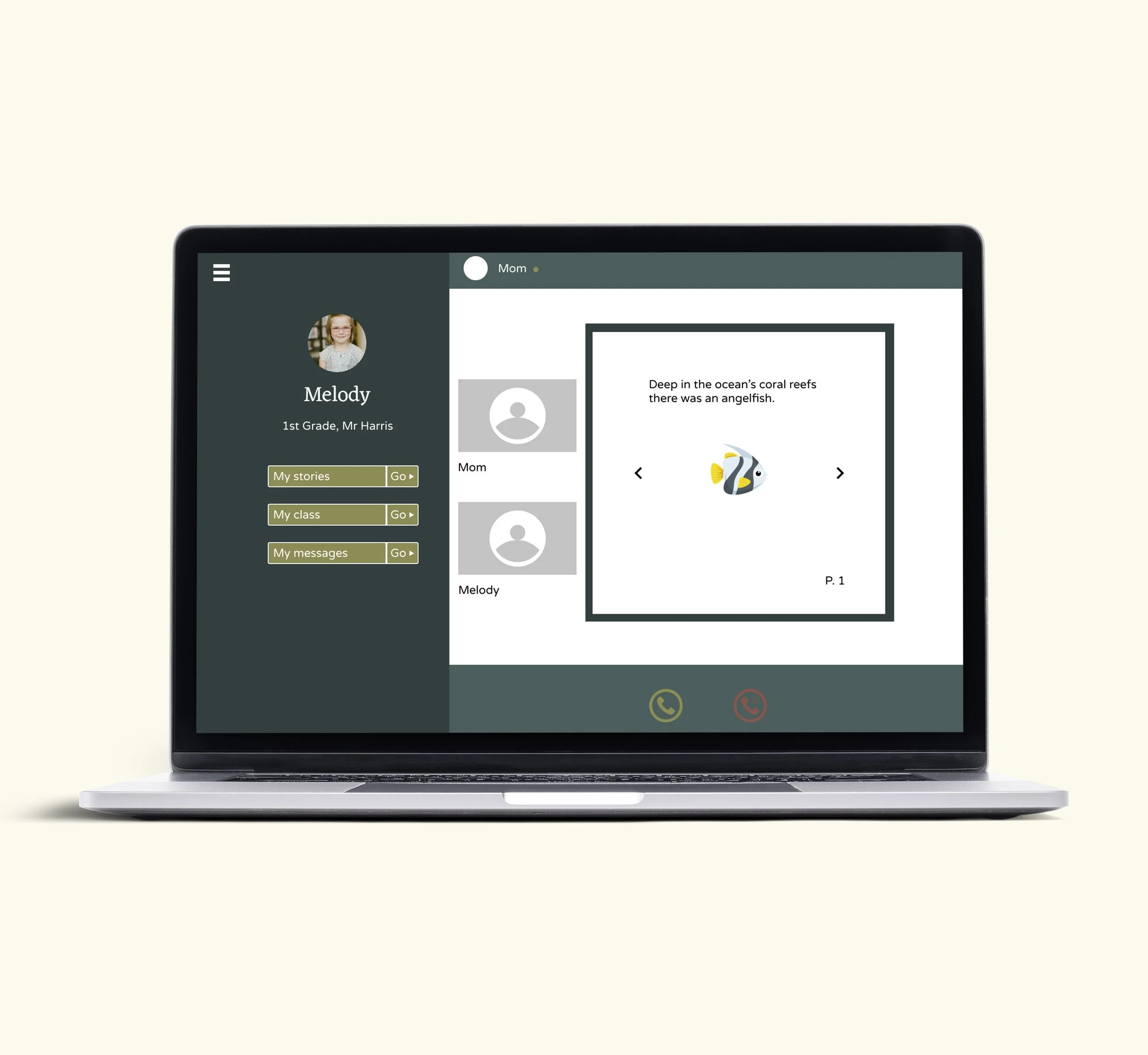
Book Wyrm
The Challenge: How might we inspire children
and their caregivers to read together?
The Solution: Book Wyrm is a web-based, multimedia program in which kids write their own representative stories, that they then publish and read with caregivers at home. The program initiates in public schools and finishes with a printed book which, research shows, is essential to early literacy success. Technical resources to deliver the programs can be provided to schools that lack them, via the traveling Book Wyrm mobiles.
Client
IDEO-inspired passion project
UX Team
Jamie Ramsay - UX Designer
Maddy Hale - UI Designer
Chales Mynhier - UX Designer
Time Frame
2 weeeks
Skills
Research, Ideation, UI Design, Story Writing, Prototyping, Slidedeck Design, Presentation
Tools & Methods
Figma, Photoshop, Heuristic Evaluation, User Interviews, Trello, Card Sort, Affinity Mapping, Comparative/Competitive Analysis, Design Studio, Maze Usability Testing, Prototyping
The Context
“The more that you read, the more things you will know. The more that you learn, the more places you’ll go.” - Dr. Seuss
Reading is a fundamental glue that ties people together. It allows us to share information and stories across cultures, time and geography. It is also an factor of socio-economic opportunity. For the last decade, the percentage of children who admit to loving to read for fun holds fairly steady at 58% for children ages 6-17. And if this passion starts at a young age, studies have shown that children who are read to 3x a week tend to score within the top 25% of reading comprehension in their schools versus kids who grew up otherwise.
However, Between the ages 6-8 reading aloud at home sharply declines. For most kids, the trend seems to show that at age 9 reading fun declines for them. Another major problem in the U.S. is book deserts, areas in which reading material is inaccessible without access to transportation, and 45% of our children are living within them. Children who grow up with physical books in the home average 3 years more of schooling than children from bookless homes, regardless of parents’ education, occupation or class, in a study conducted across 27 nations.
Caregivers have a wealth of resources at their disposal. Reading initiatives are abundant and singularly joined in their motivations. The Scholastic Book Fair is a cultural icon that promotes accessibility to reading throughout public schools. Many public libraries organize and host group
story-time reading sessions. There are even digital book repositories like Hoopla that partner with libraries to allow for digital book checkouts. But do caregivers know about them? And are they engaging?
The data was clear: establishing lasting reading habits and encouraging reading aloud amongst families is vital to creating opportunity amongst children. We were invested in developing a tool to facilitate that and break down the barriers to reading at home: engagement and access.
Our solution meets children where they are: schools. Book Wyrm is a multimedia product platform, offered in public schools, which allows children to create and publish their own stories through a digital program with age-appropriate writing prompts and images. The complexity of stories and content creation scales through the grades, promoting agency and engagement. Upon completion of the story, children can print a physical copy of their book to bring home and read with caregivers. This physical component is a key component derived from research. Children can also connect with caregivers who might reside outside the home for read aloud sessions through the program’s video conferencing, expanding accessibility. The Book Wyrm Mobile will equip underfunded schools with technical resources including printers and paper to further remove barriers to access.
Research Goals
We sought answers to these questions:
Is reading aloud important?
How much time to children spend reading?
What makes for impactful, shared experiences between children & caregivers?
What kinds of material do children enjoy reading?
What prevents children & caregivers from reading together regularly?
Do existing programs to encourage shared reading exist and do people know about them?
How can technology add to the experience of reading aloud?
Interviews
We conducted a 6 interviews with parents, via Zoom and in-person at libraries. The aim was to learn why they value reading to children and how they established reading habits. The conversations played a large role in shaping the product we designed.
Full interview transcripts and questions can be found here.
Key Takeaways:
Sharing books one likes communicates identity of caregiver to child and vice versa
Routine reading time is key to success and long-lasting habit
Letting children pick out books is key
Establishing the habit early, at a young age is important
Getting child to read on their own is a goal and marker of independence
Awareness - programs are out there, but how do we let caregivers know?
Caregivers are involved/invested with/in kids’ education
“I bought her two books, and she likes to come back and talk to me about the book and tell me what was in it and what was interesting.”
“I was very mindful of exposing him to vocabulary and what I was reading…just the exposure was important.”
“It becomes routine for them when you are consistent in doing it… that they maintain for themselves when they're able.”
Implementing Research
A time-constrained Design Studio session was pivotal to our ideation. Setting a strict 10 minute limit for each of two sessions, we broke off individually to put pencil to paper and visually draw design ideas. We discussed our first ideas and iterated in a second session, combining the best parts of each of our three solutions. Common to our designs was a way for children to be creative and even silly, based on what parents told us.
We conducted a second Design Studio session after digitally building our initial version of Book Wyrm. Out of this session we created the printing prompt. As not all public schools are equally funded, including a way to schedule the on-demand Book Wyrm Bus, equipped with printers and computers, is vital to increase accessibility to the program.
In the initial prototype, we had overlooked adding printing to the website and a touchpoint for the bus. We also created a video-conferencing feature to improve access for relatives who wanted to participate but could not be in the home. Our second design studio is also where we came up with the idea for adding a tutorial feature that initiates new users to the story creation.
Bringing inspiration and imagination into the design was key to an engaging product. Therefore, color and iconography decisions reflected that goal. We chose an orange and green palette to evoke creativity and fresh ideas, respectively. The Book Wyrm mascot, a charming dragon, is a fantastical play on the common literary phrase.
Based on what we learned from research, we recommended the following features should be implemented in the prototype, to best serve users.
Implementation: Each grade’s story line is different, increasing in complexity with age. For example, this kindergarten story line focuses on personalization by allowing the child to create their main character. These stories can increase representation.
Early testing showed the prompt on their own were not totally intuitive, so we addressed that by adding the tutorial overlay you also see here.
Recommendation: Engage through inclusive and personalized stories. Interviewed caregivers reported their reading sessions were most effective when the child chose the stories.
Recommendation: Develop children’s skills in technology and content creation to foster equal opportunity access
Implementation: Allowing children to create their own stories to read with caregivers increases engagement, but also develops creativity and technical skills. As children age and become more independent, more open-ended writing prompts will allow for greater creative freedom and enhanced visual illustration opportunities.
Recommendation: Produce printed materials to stock home libraries.
Implementation: Through Book Wyrm, teachers can schedule the on-demand Book Wyrm Bus, equipped with printers and computers, to administer the program and/or print out books. This was inspired by similar programs such as Future Maker Lab. Since number of books in a home correlates with higher literacy outcomes, this component provides a physical piece key to reading success. Future development could include annual competitions for a student’s story to be hardbound and preserved in a local library or other incentives.
Recommendation: Bring children and caregivers together to read
Implementation: In addition to children being able to bring home a physical book to read with a caregiver in their home, children can also arrange video calls through Book Wyrm to be able to read aloud with caregivers who cannot physically be in the home. We recognized that not all caregivers might be physically in the same location as a child. Therefore, building in a feature that allowed each child to be included in shared reading experiences, no matter their family circumstances. Security features would be built in to allow only authorized guardians and family members to login to Book Wyrm and participate in calls.
Testing
We carried out one round of usability testing with 9 testers through Maze. All testers completed our tasks with 100% success rate, and completion time got faster from story to story. So we were confident that our design was intuitive and learnable.
Main observations from testing:
Heat maps data showed some users were confused where to go on certain pages
Test data showed testers did not realize it was necessary to chose an item from a drop-down menu, in order to continue to the next page
Both were cases for better UX writing, so more directive language was added to the menus. As one additional way to improve the flow through story creation, we also added a tutorial that pops up for first time users (see above).
Full testing results here
Prototype
The prototype was built in Figma and takes students through story prompts allowing them to author a personalized story, with increasing complexity as they advance through the grades. In the kindergarten story, children simply create a character. Then, in the first grade story, kids customize their narratives through dropdown menus.
Demo video of Book Wyrm
Next Steps
Consider funding sources for Book Wyrm Mobile to equip underfunded schools with tech resources including printers to remove barriers to access
Research security and privacy controls for Read Along video storytime
Incorporate annual competitions to incentivize participation in printed book component which bolster home and community libraries
Test, test, test and consider accessibility for visually impaired users
Add storylines and increased complexity for other grades
Reflections
My library is and extension of me. User Interviews shined a light on just how much people select books that they share with loved ones, as a way to communicate values and identity. Parents said that they wanted to learn about their kids through their kids’ choices in books and kids were telling their parents something about themselves through books.
Keep two feet firmly on the ground. The most challenging part in designing this program was to keep a balance between the digital and the physical space in ideating a solution. I knew that other programs were heavily focused in the digital space and that my research validated that access to physical, printed material was essential to early reading success.
Never underestimate your user, no matter how young. Going into the initial design, we spent a long time discussing the technological and literacy competencies at each age and, after secondary research, realized we had underestimated children’s capabilities. Therefore we went back and researched American school system metrics, honing in on the knowledge benchmarks for each grade.
Fill the shelves with stories. I envision ways to take Book Wyrm further, like adding in accessibility for visually-impaired users. Additionally, engagement could incentivized through annual competitions for children to publish a book professionally, perhaps even get it illustrated by a notable artist. That book could be retained by a school or local library as a way of building community-based resources in book deserts. .




